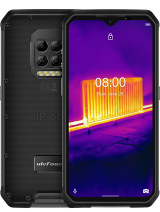Introduction
Yes, it's a Blackview review, the first of its kind on our website! The maker has been gaining traction in different markets, and its phones have finally made it to our office, too. Blackview makes affordable, rugged smartphones; some of them even have cool features like thermal or night vision cameras. And today, we will be exploring such a device - the Blackview BV8800 with a night vision camera and an impressively large 8,380mAh battery.

So, Blackview seems to be a lot like Ulefone, doesn't it? Indeed, the Blackview BV8800 we have for this review is as rugged as the (Power) Armor Ulefones, and it has both IP69K water resistance and drop-to-concrete resilience from a 1.5m distance.
The BV8800 offers a 6.58" 90Hz Full HD display and runs on the Helio G96 chipset by MediaTek. Of course, its most interesting bits underneath its reinforced body are the battery and the camera departments.
This Blackview BV8800 model weighs 367 grams, and it's not because of the thick plastic and metal shielding. The large battery inside has an 8,380mAh capacity, which should give this phone days, if not weeks, of battery autonomy.

And then there is the quad-camera on the back with a 50MP primary, an 8MP ultrawide, a 2MP depth sensor, and the showstopper - a 20MP Night Vision camera with IR emitters. The last piece will help you see and capture what's in the dark, and we are not talking Night Mode here, but real night vision like those available on security cameras or dedicated NV goggles.
So, the BV8800 is a rugged midranger with a beefy battery and a night vision camera. It is a unique piece of equipment, that's for sure, so let's scroll through its specs and get this review started.
Blackview BV8800 specs at a glance:
- Body: 176.2x83.5x17.7mm, 367g; reinforced metal frame with rubber top and bottom, plastic back; IP68/IP69K dust/water resistant (up to 1.5m for 30 mins), Drop-to-concrete resistance from up to 1.5 m, MIL-STD-810H compliant.
- Display: 6.58" IPS LCD, 90Hz, 480 nits, 1080x2408px resolution, 20.07:9 aspect ratio, 401ppi.
- Chipset: Mediatek MT6781 Helio G96 (12 nm): Octa-core (2x2.05 GHz Cortex-A76 & 6x2.0 GHz Cortex-A55); Mali-G57 MC2.
- Memory: 128GB 8GB RAM; UFS 2.1.
- OS/Software: Android 11, Doke-OS 3.0.
- Rear camera: Wide (main): 50 MP, f/1.8, PDAF; Ultra wide angle: 8 MP, f/2.2, 117˚; Macro: 2 MP; Night Vision: 20 MP, f/1.8, (IR camera), 2 IR emitters.
- Front camera: 16 MP, f/2.0, (wide).
- Video capture: Rear camera: 1440p@30fps; Front camera: 1080p@30fps.
- Battery: 8380mAh; Fast charging 33W, 31% in 30 min, 100% in 90 min (advertised), Reverse charging.
- Misc: Fingerprint reader (side-mounted); NFC; FM radio.
Even if the Blackview BV8800 is a midranger, we can spot two obvious omissions right away - there is no microSD expansion slot and a 3.5mm jack. We think those are essential for this type of rugged smartphone and would have definitely raised the BV8800 perceived value.
And that's about it. The rest seems like a solid package for a solid device. So, let's get this thing out of its box, shall we?
Unboxing the Blackview BV8800
The Blackview BV8800 arrives in a reasonably large box that contains the phone itself, a 33W USB-PD power adapter, and a USB-C cable.

The phone has a pre-applied screen protector - it's not a glass one, but one of these thin films that get smudged in no time. And while it is not our cup of tea, we do appreciate having it.
Design, build quality, handling
The Blackview BV8800 is one beautiful, rugged smartphone with a catchy design and solid protection. It was not designed for the mainstream user but for those who need their phone to be with them and even help them in harsh environments where other handsets won't survive for long, like construction sites, factories, or even extreme hiking.

The Blackview BV8800 is both water and shockproof and can take a lot of beating. It has both IP68 and IP69K certifications for dust and water - both normal and pressurized - resistance. It is also shockproof and can easily survive a drop on a concrete floor from up to 1.5m.
There is more! The Blackview BV8800 also covers some MIL-STD-810H standards like high humidity, temperature and altitude shocks, and transport shock. Not surprising, given the rubber elements across its body.

The Blackview BV8800 measures 176.2 x 83.5 x 17.7 mm and weighs 367 grams, which is far from lightweight and compact. Yet, we've seen thicker and heavier rugged devices, so we think that Blackview has struck the right balance between ruggedness, battery capacity, and pocketability.
Most of the front is occupied by the 6.58-inch 90Hz IPS LCD screen. It is surrounded by thick bezels, enough to put a selfie camera on them, and yet Blackview has chosen a notched panel, and the 16MP front camera is in the droplet-shaped cutout. Go figure!

Above the screen is the earpiece, a couple of sensors, and a notification LED light.

The screen is shielded with flat tempered glass, but we don't know its brand. The phone arrives with a pre-installed thin screen protector, which gives it an extra scratch resistance but makes it much more prone to fingerprints and smudges.
The matte back of the Blackview BV8800 is a good-looking piece of thick plastic with metal chassis underneath. Some of the metal frame also stretches over the back for extra grip and shock resistance.

There are two features of interest on the back - the camera setup and a giant lanyard eyehole around the bottom. You can also spot a number of screws across the entire back.
The camera island contains the 50MP primary, the 20MP Night Vision, the 2MP depth and the 8MP ultrawide cameras. Above the shooters, you will see a powerful dual-LED flash, while below them are the two IR emitters used by the Night Vision camera.

There are two small holes on the back panel, and we are pretty sure there is a microphone underneath at least one of them.
The frame of the Blackview BV8800 is quite thick and grippy. Its top and bottom and all four corners are reinforced with what looks like some thick TPU (rubber-like plastic) material, which is great for shock resistance.

The left and right sides are made of brushed metal.
The left side houses the dual-SIM tray and the extra shortcut key intended for PTT purposes, but you can configure it to serve your purposes.

The right side of the Blackview BV8800 has the volume and power/lock keys. The surface of the power button also contains the always-on fingerprint scanner, which takes a while to set up, but works flawlessly.

There is nothing on the top of the Blackview BV8800.

The bottom has the mouthpiece, the speaker, and the USB-C port with a special protective lid.

Handling the Blackview BV8800 was an overall great experience - the phone has all sorts of protections, yet it offers catchy looks and an incredibly comfortable grip. The BV8800 is not an enormous device and can be carried around in most pockets. You probably need both of your hands when you are using it, as single-handed operations are almost impossible outside calls and video playback.
Our only beef is with the notch - it was completely unnecessary.
Display
The Blackview BV8800 packs a 6.58-inch IPS LCD screen of extended 1080p resolution. The panel has a waterdrop-shaped notch for reasons that are beyond our comprehension. The screen supports a wide color gamut and a 90Hz refresh rate.

So, the display panel has 2,408 x 1,080 px or 401ppi density. There is no HDR support. And there is no dynamic refresh rate control - everything runs at 90Hz no matter the content. Or that's what the Android refresh rate indicator says anyway.
We've completed our display measurements, and the numbers are solid - the maximum brightness is about 500nits in both manual and auto tuning. This, combined with the reasonably deep blacks, led to an excellent contrast ratio of about 1300:1.
The minimum brightness we've captured at point white was 6.6 nits.
| Display test | 100% brightness | ||
| Black, |
White, |
||
| 0.368 | 496 | 1348:1 | |
| 0.403 | 501 | 1243:1 | |
| 0.279 | 406 | 1455:1 | |
| 0.357 | 550 | 1541:1 | |
| 0.307 | 401 | 1306:1 | |
| 0 | 383 | ∞ | |
| 0 | 800 | ∞ | |
| 0 | 479 | ∞ | |
| 0 | 760 | ∞ | |
Finally, let's talk about color accuracy. There are three color modes Standard, Bright, Special (manual), and they all correspond to the DCI-P3 color space, they just offer different color saturation. Choosing the Warmest option in the manual mode yields the best results with a fairly accurate presentation, while the rest offers punchier colors across the board.
Battery life
The Blackview BV8800 is powered by a large battery with an 8,380mAh capacity. It supports fast wired charging of around 30W.
You bet the Blackview BV8800 aced our battery life test and scored one of the highest endurance ratings we've had from a smartphone to this day. The BV8800 offers more than two and a half days of 3G calls; it can last more than a day on web browsing and nearly one day when playing videos.
Combined with the frugal standby consumption, the Blackview BV8800 scored a 199-hour endurance rating.

Our battery tests were automated thanks to SmartViser, using its viSerDevice app. The endurance rating denotes how long the battery charge will last you if you use the device for an hour of telephony, web browsing, and video playback daily. More details can be found here.
Video test carried out in 60Hz refresh rate mode. Web browsing test done at the display's highest refresh rate whenever possible. Refer to the respective reviews for specifics. To adjust the endurance rating formula to match your own usage patterns check out our all-time battery test results chart where you can also find all phones we've tested.
Charging speed
The BV8800 supports fast wired charging up to 27-33W depending on the source you find. In our testing, it never went above 27W.
A 33W USB-PD power adapter is bundled with the device and a compatible USB-C-to-C cable.

We recorded 38% charge in 30 minutes, which may not be the most impressive speed, but considering the sheer battery capacity we're dealing with here, this is bound to give you a few days of extra autonomy.
30min charging test (from 0%)
Higher is better
- Xiaomi Redmi Note 11 Pro+ 5G
100% - Xiaomi Redmi Note 11 Pro 5G
74% - Sony Xperia 1 IV
47% - Blackview BV8800
38% - Ulefone Armor 9
35% - Samsung Galaxy M51
35% - Ulefone Armor 7
27% - Ulefone Power Armor 13
27% - Samsung Galaxy M30s
21%
A full charge took 101 minutes, which is reasonably fast, considering the battery size.
Time to full charge (from 0%)
Lower is better
- Xiaomi Redmi Note 11 Pro+ 5G
0:16h - Xiaomi Redmi Note 11 Pro 5G
0:45h - Blackview BV8800
1:41h - Sony Xperia 1 IV
1:42h - Samsung Galaxy M51
1:47h - Ulefone Armor 9
2:30h - Ulefone Armor 7
2:40h - Ulefone Power Armor 13
3:03h
If you connect another device via the USB-C cable, the Blackview BV8800 would also provide reverse charging off its large battery - almost like a power bank.
Speaker loudness and quality
The Blackview BV8800 has one bottom-firing speaker, and it scored an Average mark when it comes to loudness.

On the other hand, we'd rate its quality as Very Good because it has great mid-tones and solid bass, though the high-pitched notes could have been better.
Use the Playback controls to listen to the phone sample recordings (best use headphones). We measure the average loudness of the speakers in LUFS. A lower absolute value means a louder sound. A look at the frequency response chart will tell you how far off the ideal "0db" flat line is the reproduction of the bass, treble, and mid frequencies. You can add more phones to compare how they differ. The scores and ratings are not comparable with our older loudspeaker test. Learn more about how we test here.
Android 11 with DoKe OS 3
The Blackview BV8800 comes with Android 11 out of the box with DoKe OS 3 launcher. Even if there is an extra layer of the interface, the experience is close to vanilla Android and mostly clutter-free.

The software looks a lot like the vanilla Android, minus the icons. The home screen, lock screen, notification shade, and the recent apps menu resemble those of the stock Android.





Android OS on Blackview BV8800
Looking deeper into the Settings menu reveals the changes that Blackview has made - there is a Personalization page with themes and icons, gesture and key settings where you can assign three different functions to the side button on the left - one upon the short press, another one - on long press, and the third option is when you double click it. You can also swap the Google homescreen for a Smart one populated with various shortcuts, widgets and smart suggestions.
There is an app drawer available on the Blackview BV8800, but you can disable it if that's not your thing.
The app package is pretty straightforward. The default Android apps are pre-installed, so you have a gallery, a media player, and a file manager. There is also an FM radio app by Blackview, a custom Notebook app with support for reminders, and a ToolBag app.
The FM radio requires a wired USB-C headset to work.
The ToolBag is probably the most powerful app you will find on BV8800.
It offers Compass, Level tool, Flashlight, AR level for paintings, Height meter (seems like a gimmick), Magnifier, Alarm bell, Protractor, Sound meter (uses the microphone), Pedometer, Bubble level, Plumb bob and Barometer.
There are no ads across the UI whatsoever, so you can be sure you won't be bothered by unwanted spam here and there. And that pretty much covers the Blackview BV8800 starter package.
Performance and benchmarks
The Blackview BV8800 employs the Helio G96 chipset by MediaTek. It is fabricated on the 12nm FinFET manufacturing process from TSMC. The Helio G96 has the usual octa-core CPU with two high-performance Cortex-A76 cores clocked at 2.05GHz and six energy-efficient Corext-A55 cores working at 2.0GHz.
The Helio G96 chip features a dual-core Mali-G57 GPU. Unlike the previous G9x chips, we have a dual-core configuration instead of quad-core, which is somewhat disappointing.
Finally, the Blackview BV8800 is available in just one configuration with 8GB LPDDR4X RAM and 128GB non-expandable storage.
We ran the usual benchmarks, and the scores are in.

The CPU benchmarks are alright - the processor is capable of handling whatever you throw at it these days.
GeekBench 5 (multi-core)
Higher is better
- Samsung Galaxy A52s 5G
2801 - Xiaomi Redmi Note 11 Pro+ 5G
2225 - Infinix Note 11 Pro
1800 - Xiaomi Redmi Note 10 Pro
1780 - Blackview BV8800
1752 - Xiaomi Redmi Note 11 Pro
1729 - Ulefone Power Armor 13
1610 - Ulefone Armor 9
1498
GeekBench 5 (single-core)
Higher is better
- Samsung Galaxy A52s 5G
771 - Xiaomi Redmi Note 11 Pro+ 5G
736 - Xiaomi Redmi Note 10 Pro
569 - Infinix Note 11 Pro
520 - Blackview BV8800
516 - Xiaomi Redmi Note 11 Pro
511 - Ulefone Power Armor 13
502 - Ulefone Armor 9
401
The GPU performance is okay, it won't do for HFR gaming, but it's alright if you want to spend a few hours playing games. Just don't expect to get the best visuals - if you want a smooth experience, you will need to lower a lot of the graphics settings.
GFX Car Chase ES 3.1 (onscreen)
Higher is better
- Samsung Galaxy A52s 5G
28 - Xiaomi Redmi Note 11 Pro+ 5G
22 - Ulefone Power Armor 13
18 - Xiaomi Redmi Note 10 Pro
16 - Xiaomi Redmi Note 11 Pro
12 - Infinix Note 11 Pro
11 - Blackview BV8800
10 - Ulefone Armor 9
7.9
GFX Manhattan ES 3.1 (onscreen)
Higher is better
- Samsung Galaxy A52s 5G
49 - Xiaomi Redmi Note 11 Pro+ 5G
38 - Ulefone Power Armor 13
29 - Xiaomi Redmi Note 11 Pro
22 - Blackview BV8800
20 - Infinix Note 11 Pro
20 - Ulefone Armor 9
17
3DMark Wild Life Vulkan 1.1 (offscreen 1440p)
Higher is better
- Samsung Galaxy A52s 5G
2491 - Xiaomi Redmi Note 11 Pro+ 5G
2014 - Ulefone Power Armor 13
1487 - Xiaomi Redmi Note 11 Pro
1101 - Infinix Note 11 Pro
1100 - Blackview BV8800
1094
Quite expectedly, the AnTuTu tests put the BV8800 scores around the bottom of the chart.
AnTuTu 8
Higher is better
- Samsung Galaxy A52s 5G
429675 - Xiaomi Redmi Note 11 Pro+ 5G
375528 - Xiaomi Redmi Note 10 Pro
295442 - Ulefone Power Armor 13
294194 - Infinix Note 11 Pro
290797 - Xiaomi Redmi Note 11 Pro
261309 - Blackview BV8800
254849 - Ulefone Armor 9
197000
AnTuTu 9
Higher is better
- Samsung Galaxy A52s 5G
506432 - Xiaomi Redmi Note 11 Pro+ 5G
437872 - Ulefone Power Armor 13
351678 - Infinix Note 11 Pro
343527 - Xiaomi Redmi Note 11 Pro
319093 - Blackview BV8800
288964
Finally, we ran the two stress tests we always do - CPU Throttle and 3D Mark Wild Life.
The Blackview BV8800 did well on the CPU Throttle test by keeping about 70% of its maximum performance during an hour of maximum CPU usage.
Later, it scored 99.6% stability on the 3D Mark Stress Test - an outstanding result. These numbers mean the BV8800 offers top-notch stability and long-lasting peak performance. Even better, we never felt the phone hot, it barely gets warm even when using 100% of the available hardware resources.
The Blackview BV8800 offers mediocre performance, though stable and reliable. It's not a gaming phone, but it wasn't made to be such. We'd say the G96 chip does an adequate job even if we would have preferred it to have been a bit higher tier.
Quad-camera with Night Vision
The Blackview BV8800 features a quad camera on the back. It's a budget setup, yet a unique one that allows quite the versatility for a rugged device. There is a 50MP primary snapper, an 8MP ultrawide shooter, a 2MP depth sensor, and a 20MP Night Vision camera.
There is also a 16MP selfie camera at the front of the phone.

The primary camera uses a 50MP Samsung JN1 Quad-Bayer sensor with 0.64µm pixels - it sits behind an f/1.7 32mm lens - PDAF is available here.
The 8MP ultrawide shooter uses a GalaxyCore GC8034 sensor with 1.12µm pixels and has f/2.2 19mm lens.
Finally, there is another GalaxyCore sensor for depth purposes. The hardware reading apps list it as 5MP, while the maker claims it's 2MP - go figure.

The fourth and final camera on the back uses a 20MP Sony IMX376 with 1.0µm pixels and a Quad-Bayer filter. It sits behind an f/1.8 aperture lens and has a similar field of view as the main camera. The focus is fixed at infinity.
Finally, the front camera has a 16MP Samsung S5K3P9 sensor with a Tetracell color filter and 1.0µm pixels, with a 27mm f/2.0 lens. The focus is fixed.

The camera app is nothing we haven't seen - you swipe to switch between modes - Night, Video, Photo, Beauty and More. Portrait, Pro and 50MP modes are available within More.
On the viewfinder itself, you will find tree-like shortcuts corresponding to 0.6x, 1x and 2x zoom levels. The 2x is doing digital zoom, obviously. Nearby is also the Night Vision key, which switches to the Night Vision camera.

The Pro mode works on the main camera only - it offers shutter speed (30s max), white balance, ISO (up to 1600), focus, and exposure compensation.
Photo quality
The main camera saves 12MP photos by default, and those are outstanding, especially considering the phone's budget class. There is plenty of resolved detail, natural colors, well-handled noise, adequate dynamic range and very good contrast.
Even better, the image processing is incredibly natural with gentle sharpening, and overall, the photos are balanced and great looking across the board. There are a few makers out there that can take notes from the foliage presentation.
The zoom shortcut on the viewfinder offers digital zoom done by cropping and upscaling from the standard output. The photos are lacking in detail and quite soft but still usable, so if you need to zoom in, this is the easiest way.
There is a 50MP mode that offers an upscaled version of the 12MP standard photos, and that's hardly of any use.
The 8MP ultrawide camera saves usable photos; we'd even call them likable, if you are not into pixel peeing. The colors are good, and the noise is quite low.
If you do view them at 100%, though, you will see the resolved detail is below average, they are over-sharpened, and the dynamic range is often low.
The portraits from the main camera are not good. The subject separation is bad, the dynamic range is subpar, and the blur somehow makes our eyes hurt a bit.
The 16MP selfies, even if upscaled as this is a Tetracell camera, are excellent. They are sharp, and there is enough detail for a selfie camera, the subjects are well exposed, and the noise is low. The colors are good, and so is the contrast.
Oddly, the selfie portraits are better than the ones taken with the main camera with the supposed help of a depth sensor. The subject separation is okay, the exposure is good, and the colors are nice. The blur is likable, too.
The low-light photos from the main camera are great, all things considered. They have a lot of detail, and yet the noise is low, the colors are preserved well, and the dynamic range is good. Overall, these are some solid photos, much better than we expected them to be.
There is Night Mode available on the BV8800, but we don't recommend using it. It does improve the exposure and brightens the image, and it boosts the color saturation. But it introduces a ton of noise, which gets in the way of the quality. We prefer the natural-looking standard photos instead of this mess.
The 8MP low-light ultrawide photos are good. They are noisy and soft, the colors are very good, and the exposure turned out better than expected.
Even if you can switch to Night Mode for the ultrawide camera, it does nothing.
The Night Vision camera uses a Quad-Bayer 20MP sensor and the assistance of two powerful IR emitters. It always saves monochrome photos.
And the 20MP Night Vision shots are poor in detail as they are upscaled from 5MP. But they do reveal more detail, especially in the shadows. Even if the room is pitch dark, you will clearly see everything that is in there.
The camera has its focused locked at infinity, and objects close to the camera are out of focus.
This camera wasn't meant for Instagram bragging; it's meant as a tool for professionals - thanks to it, you can clearly see in completely dark rooms and reveal stuff in shafts, vents and other hard-to-reach spots.
And here are photos of our usual posters taken with the Blackview BV8800. You can see how it stacks up against the competition. Feel free to browse around and pit it against other phones from our extensive database.



Blackview BV8800 against Ulefone Power Armor 13 and the Galaxy A52s in our Photo compare tool
Video recording
The video resolution for the main and Night Vision cameras maxes out at 2560x1440 (1440p), while the ultrawide and selfie cameras are limited to 1080p@30fps. Optional electronic stabilization is available across all shooting modes.
The videos 1440p videos have a solid 50 Mbps bitrate at right around 30fps. The 1080p clips also look promising with a 20Mbps bitrate. Audio is captured stereo with 256Kbps bitrate.
The 1440p clip from the main camera is great - the footage is sharp and detailed, the colors are accurate, and the contrast is high. The dynamic range is okay.
There is an HDR shortcut on the display, which improves the dynamic range by lowering the contrast. If your footage has too many blown highlights, you can use this option. It's not a real HDR video that requires compatibility across devices, it's just a small trick to improve the dynamic range when needed.
Unfortunately, the audio is poor - it's like one of the channels is almost entirely missing, and the whole thing sounds unpleasant with compression-like artifacts.
The 1080p footage from the ultrawide camera is good. The clip has enough detail and good sharpness, accurate colors and good contrast. The noise is kept low. The dynamic range is okay for such a type of camera.
The digitally zoomed Full HD videos are likable - they show you what's far away with good detail, contrast and colors.
The low-light videos from the main camera are overrun by noise and unusable, while the scenes turned out too bright for the Night Vision camera.
Finally, here is the Blackview BV8800 5G in our video tool so you can make your own comparisons.



1440p: Blackview BV8800 against Tecno Camon 18 Premier and the Infinix Note 11 Pro in our Video compare tool
Alternatives
The Blackview BV8800 offers a lot for a €350 or so smartphone - it has one of the most durable builds you can get today with all sorts of endurances. There is a 90Hz Full HD display on top of hardware that's quite adequate for a rugged smartphone.
The bits that really stand out to us are the Blackview BV8800's Night Vision camera and the large 8,380mAh battery. The phone can navigate you through pitch black environments, while its battery can last more than a week on a single charge.

Ulefone will gladly offer you similar rugged phones with various tricks. Take the Ulefone Power Armor 13, for example - it has a laser distance measuring tool instead of a Night Vision camera and will give you an even larger 13,200mAh battery. The phone costs about €50 over the BV8800, but if you like the idea of having such range finding function on your phone - you should check it out. Plus, the Ulefone has more powerful graphics even if the screen refresh rate is limited to 60Hz.
You could also consider the Ulefone Armor 9 for its FLIR thermal camera and the 6,600mAh battery. It is a more compact phone with a 6.3-inch 60Hz display, but if you need thermal imaging in your line of work, that's a great option.
Blackview also offers the BL8800 Pro with a similar display, battery, hardware and camera experience to the BV8800, but instead of a Night Vision camera, you will get a FLIR thermal one. The phone should be priced around the same as the BV8800.



Ulefone Power Armor 13 • Ulefone Armor 9 • Blackview BL8800 Pro
Our verdict
The Blackview BV8800 is an interesting smartphone for its incredibly rugged build, the solid all-around package, the Night Vision camera and the giant battery with fast charging. And the best part, it is reasonably priced at about €350.
We were impressed with the battery life and the overall design, and we did like the camera quality despite the few caveats like the bad portraits and mediocre ultrawide photos. The Night Vision cam can be a valuable tool in the dark, and we can imagine people finding clever purposes for it.

The Blackview BV8800 isn't a fast phone meant for gaming, and it lacks a few things like an audio jack and microSD storage expansion. But it makes up for those with NFC and FM radio, notification LED light, and solid photo and video performance - the latter being a rare sight on a rugged device.
If you need a rugged smartphone with reasonably good hardware and solid user experience across the board, we do recommend giving this Blackview BV8800 a try. In fact, the BV8800 or the BL8800 Pro should be around the top of your shortlist if you want a rugged phone with a Night Vision or a FLIR thermal camera. You won't be disappointed. It's not a Galaxy S22 Ultra, sure, but it's not a sluggish CAT phone either.
Pros
- Rugged design, IP69K, shock proof.
- Chart topping battery life, fast charging, reverse wired charging.
- Adequate performance, 90Hz display.
- Great photo and video quality from the main and selfie cameras.
- Night Vision camera is not just a gimmick.
- NFC, FM radio, notification LED.
Cons
- No audio jack, no adapter in the box.
- No microSD expansion.
- Subpar ultrawide and portrait experience.
- Why the notch?
from GSMArena.com - Latest articles https://ift.tt/CbXfDec
via IFTTT
Bagikan Berita Ini

























































































































0 Response to "Blackview BV8800 review"
Post a Comment